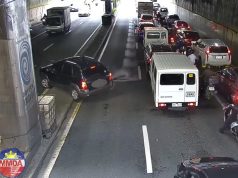
Suggestions to ease traffic were once again raised after the Metro Manila Development Authority released a resolution requiring certain local government units to adjust their working hours to ease rush hour congestion.
The MMDA, through the MMDA Resolution 24-08 (Series of 2024), is mandating 17 LGUs in the National Capital Region to adjust their office hours to 7 a.m. to 4 p.m. starting April 15 in a bid to ease the daily traffic congestion in the metro.
Usual government office hours are from 8 a.m. to 5 p.m.
The resolution would be applicable to the cities of Caloocan, Las Piñas, Makati, Malabon, Mandaluyong, Manila, Marikina, Muntinlupa, Navotas, Parañaque, Pasay, Pasig, Quezon, San Juan, Taguig, Valenzuela, and the municipality of Pateros.
The traffic authority said the adjustment of the working hours was made in consideration of the private sector’s standard working hours, adding that the similar schedule of 8 a.m. to 5 p.m. is “contributing to traffic congestion in Metro Manila.”
The traffic authority explained that adjusting working hours was made in consideration of the private sector’s standard 8 a.m. to 5 p.m. schedule, which is identified as a contributor to traffic congestion in Metro Manila.
The MMDA also reasoned that “government transactions commonly commence early, prior to the 8 a.m. start, and are typically concluded before 5 p.m.”
It also stated that based on its comprehensive study, there is a “potential effectiveness of implementing a standardized working schedule for government offices in Metro Manila, particularly during peak hours, in reducing traffic congestion.”
The MMDA is also “strongly” encouraging national government agencies in the NCR to adopt a similar adjusted working schedule “to distribute the ingress and egress of employees, thereby mitigating traffic congestion during peak hours.”
While the initiative was well-intentioned, it failed to impress some Filipinos who gave their own suggestions in response to the resolution.
“Ang solusyon ay regional development. Palaguin ang mga industriya sa probinsya [nang] dumami ang competitive na oportunidad para sa mga probinsyano at ‘di na pumunta sa Metro Manila kung saan concentrated ang mga oportunidad,” a Facebook user wrote.
“Pangalawa, gawin ding competitive ang pasahod sa probinsya, ipantay sa sahod ng mga nasa Metro Manila para ma-incentivize na manatili sa probinsya ang mga workforce nila at dun mag-contribute sa economic development ng lugar nila. Pangatlo, MAHIYA NA ANG MGA MAGNANAKAW SA GOBYERNO AT IKULONG,” the user added.
Some have suggested that the MMDA should consider allowing LGUs to implement remote work setups or, at the very least, hybrid setups combining onsite and remote work.
“Not sure why the MMDA refuses the proven efficacy of the work-from-home setup for non-essential offices in both local [and] national government. I don’t see it here. They really are car-centric dinosaurs,” history advocate Kristoffer Pasion commented.
“All that ‘comprehensive examination’ just to avoid hybrid or more work-from-home days for jobs that don’t require onsite presence,” another user wrote.
Others also urged the MMDA to explore other options, such as modifying the vehicle number coding scheme and enhancing the overall public transportation.
Andaming options to regulate traffic congestion:
1. Alternative work arrangement
2. Modified coding system
3. Enhanced public transportationTapos pipilii yung adjustment ng buong metropolitan para walang traffic? https://t.co/kXCDAa3BBZ
— ralph lagrada 🪀🚂🍳 (@ralphlagrada) April 10, 2024
Last February, some Filipinos also aired suggestions to ease the traffic congestion in the metro following a proposal to install a “traffic czar.”
The suggestions include implementing remote working setups, developing policies that prioritize people over cars, and improving provincial areas to reduce urban migration to the metro.
ALSO READ: ‘Not a czar’: Pinoys give suggestions to resolve Metro Manila traffic woes
In January, TomTom noted in its 2023 Traffic Index that the NCR was the worst place in the world to experience metro traffic.
The TomTom Traffic Index assesses the traffic conditions in metropolitan areas across the globe, analyzing factors like road infrastructure, speed limits and vehicle flow.
The traffic index said that Metro Manila drivers spent an average of 25 minutes and 30 seconds just to travel 10 kilometers in 2023. This is the slowest, compared to 387 areas mentioned in the study.
The data translates to 117 hours lost in traffic last year for those in the NCR, a time equivalent to almost five days.









